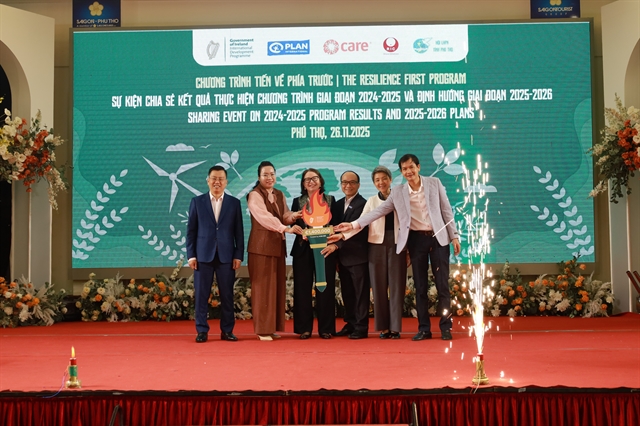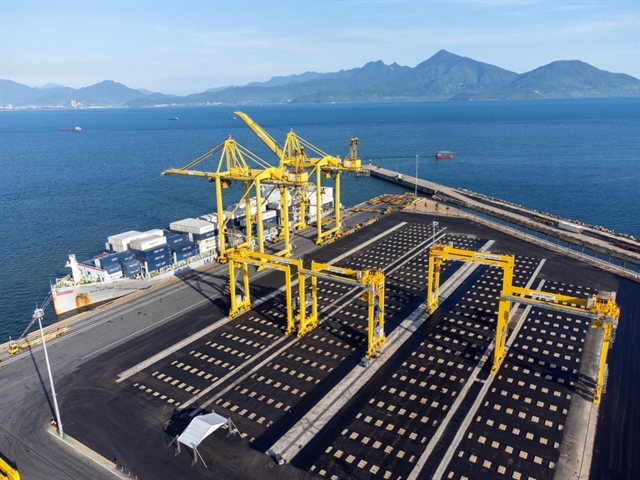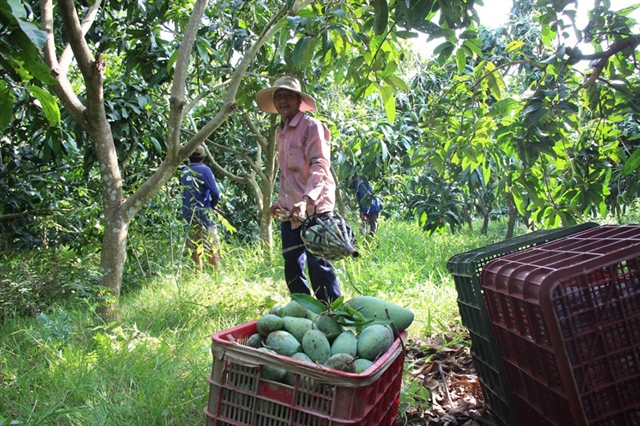 Society
Society

 |
| Farmers in Đồng Tháp Province’s Cao Lãnh District harvest ripe mangoes by hand, showcasing the region's traditional yet meticulous agricultural practices. Photo baoangiang.com.vn |
MEKONG DELTA — As Việt Nam shifts its economic gears toward higher-value agricultural exports, mangoes are gaining recognition as a flagship fruit with the potential to secure a robust foothold in international markets.
Across the fertile Mekong Delta, particularly in the provinces of Tiền Giang and Đồng Tháp, a quiet revolution is underway.
These southern localities are not only cultivating mangoes but cultivating ambition — reimagining this golden fruit as a national brand.
Once relegated to the domestic market or informal trade channels, mangoes are now being transformed into a structured export commodity.
The rise of certified production zones, smart farming technologies, and international branding efforts are reshaping the industry from orchard to overseas markets.
From traditional farms to modern orchards
Đồng Tháp, with more than 14,800 hectares under mango cultivation, is among the largest mango-growing regions in Việt Nam.
Most farms are clustered in Cao Lãnh District and Cao Lãnh City, which collectively produce over 130,000 tonnes of mangoes annually.
Similarly, Tiền Giang maintains over 11,000 hectares of mango plantations, centred primarily in districts such as Cai Lậy and Châu Thành, yielding approximately 78,000 tonnes a year.
Traditionally grown for local consumption, these mangoes are now finding their way into high-demand global markets thanks to strategic restructuring.
According to the Ministry of Agriculture and Environment, Việt Nam exported around 200,000 tonnes of mangoes in 2023, earning close to VNĐ4.3 trillion (roughly US$180 million).
Việt Nam’s mangoes now appear on the shelves of major supermarket chains in Japan, South Korea, Australia, New Zealand, the EU, and the United States.
A landmark moment occurred in 2022 when 18 tonnes of Hòa Lộc mangoes — the pride of Tiền Giang — were successfully exported to the US after meeting stringent phytosanitary requirements. The shipment not only opened new doors but symbolised the mango’s readiness for the world stage.
The power of branding: carving out an identity
While volume and quality matter, so too does market identity. As part of their export strategy, both provinces are now placing strong emphasis on branding — a vital element in ensuring long-term competitiveness in global markets.
In 2019, Đồng Tháp secured geographical indication (GI) protection for Cao Lãnh mangoes, formally linking the fruit to its region of origin.
The GI status ensures authenticity and adds a premium value in discerning markets where origin and traceability are paramount.
These mangoes are now marketed not only as delicious fruit but as a symbol of Vietnamese terroir — the unique environmental and cultural factors that define agricultural products.
Tiền Giang, meanwhile, has taken steps to strengthen the brand identity of its signature Hòa Lộc mango. Renowned for its golden flesh, rich fragrance, and minimal fibre, the Hòa Lộc mango can fetch up to $10 per kilogram in retail markets abroad.
The province recently invested VNĐ5 billion (approximately $195,000) to support packaging design, promotional campaigns, and brand development for this variety.
Both provinces have adopted QR code-based traceability systems. These allow consumers to scan and track the fruit's journey — from orchard through processing and into their hands.
The move enhances transparency, counters counterfeit products, and builds consumer confidence in quality and origin.
 |
| Đồng Tháp Province attaches QR codes to trace each fruit’s origin, meeting export standards and enhancing brand identity. VNS Photo Văn Châu |
Structuring the supply chain: cooperatives take the lead
Key to the mango sector’s transformation is the strengthening of grower cooperatives. These grassroots organisations bridge the gap between small-scale farmers and international buyers by facilitating knowledge transfer, enforcing quality standards, and offering collective bargaining power.
In Đồng Tháp, there are currently 21 mango cooperatives managing more than 1,000 hectares of certified growing areas. The My Xuong Mango Cooperative in Cao Lãnh is among the most successful.
Members are trained in GlobalGAP standards, integrated pest management, and techniques for producing mangoes during the off-season — a time when prices are typically higher.
"Before joining the cooperative, I sold to traders for unstable prices," said Nguyễn Văn Hòa, a veteran grower from Mỹ Hiệp Commune. "Now, we negotiate export contracts directly and get better prices."
On average, cooperative members report annual incomes of up to VNĐ250 million per hectare (around $9,800), particularly when cultivating during the off-season.
The coordinated model also ensures consistent supply, optimised harvest timing, and reduced post-harvest losses — all crucial for meeting export demand.
Post-harvest innovation: adding value beyond the farm
A major bottleneck in Việt Nam’s fruit exports has long been the overreliance on fresh produce. To overcome this, Tiền Giang and Đồng Tháp are making substantial investments in processing capacity and value-added products.
In early 2024, Tiền Giang inaugurated a new dried mango processing facility in Châu Thành District. With a total investment of VNĐ8 billion ($313,000), the plant can process up to 2 tonnes of fresh mangoes per day.
The dried mangoes are exported primarily to Japan and South Korea, fetching prices of up to $12 per kilogram. Notably, the plant operates on a zero-waste model, using mango peels and seeds to produce bio-compost and livestock feed.
Đồng Tháp, meanwhile, is nurturing a cluster of agri-tech start-ups. One standout is Green Farm Foods in Sa Đéc City, which produces freeze-dried mango slices and mango puree for markets in Singapore, Germany, and Thailand.
These processed products are increasingly popular with health-conscious consumers seeking convenient, shelf-stable options without added sugar or preservatives.
Both provinces are also investing in cold storage systems to extend shelf life. Tiền Giang has built two new cold warehouses, each with 100-tonne capacity. Moreover, to meet the growing demand for sustainable packaging, some cooperatives have begun using biodegradable materials made from banana fibre instead of conventional polystyrene foam.
 |
| At a new processing plant in Tiền Giang Province’s Châu Thành District, dried mango slices packaged for export to Japan—part of the province’s value-added export strategy. VNS Photo Văn Châu |
Smart farming: digital tools for the modern mango
Technology is becoming an integral part of mango cultivation. From internet-of-things (IoT) irrigation systems to drone-based pest monitoring and blockchain-enabled traceability, innovation is changing how mangoes are grown and marketed.
Đồng Tháp is leading several pilot programmes that integrate blockchain technology into mango traceability systems.
These systems allow exporters and regulators to access real-time data on pesticide use, harvest timing, and supply logistics — a major plus for international buyers concerned with food safety and sustainability.
Trần Thị Ngọc Lan, a farmer in Cao Lãnh District, shared her experience: "Since adopting smart irrigation and pest sensors, we’ve cut water use by 20 per cent and reduced chemical inputs by nearly a third. Our mangoes now meet more stringent requirements, and we can charge a premium."
In 2024, Đồng Tháp hosted an International AgriTech Innovation Fair, attracting firms from Japan, Israel, and the Netherlands. The event focused on deploying AI-powered sorting machines, disease prediction algorithms, and modular cold chain solutions for export hubs.
Export ambitions: aiming for $100 million and beyond
With the mango sector gaining momentum, both Tiền Giang and Đồng Tháp have set bold targets. Đồng Tháp plans to reach $100 million in mango exports by 2030, up from an estimated $40 million in 2023.
Tiền Giang, meanwhile, aims to expand its certified mango growing areas from 1,100 hectares to over 2,000 hectares and construct five new processing facilities.
However, challenges remain. Fragmented logistics, fluctuating input costs, inconsistent export standards, and volatile international prices are persistent hurdles.
Experts say that to truly scale up, Việt Nam must streamline its export approval processes, unify regional branding strategies, and increase public-private investment in R&D.
"There’s a clear roadmap," said Dr. Lê Văn Bảnh, an agricultural economist. "But success depends on coordination — from farmers to ministries to trade partners."
Still, optimism runs high. The mango’s journey — from sun-drenched orchards in the Mekong Delta to refrigerated containers bound for Tokyo, Berlin, or Los Angeles — reflects not only agricultural excellence but also the resilience and innovation of Vietnamese farmers and entrepreneurs.
"Vietnamese mangoes are not just fruit," said Bùi Thị Thương, an exporter from Tiền Giang. "They carry our farmers’ hopes, our cultural pride, and now, a passport to the world." – VNS




